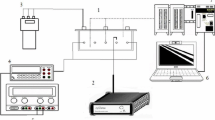Abstract
In today’s lighting industry, with developing technology and a widened usage area, LEDs have become very popular due to their higher energy efficiency and longer life. In the present study, the effect of electronic components on printed circuits and the radiation level on light output was studied. The performed analysis was validated with an experimental method. For the finite volume method, FloEFD 2019, commercial software, was used. The ambient temperature was assumed to be 23 °C. The value of solar irradiance was taken as 1009 W/cm2. LEDs on a PCB were driven at 70 mA at first and then at 50 mA, and, by exerting power on all electronic components, analyses were performed. Both sides of the PCB were examined, and, in order to achieve efficient heat conduction, the power and distribution of the electronic components on the back side of the LEDs were optimized. With a new electronic circuit design, analyses were performed at 50, 55, 60, 65, and 70 mA. It was determined that the highest light output was achieved at 65 mA and that the distribution of electronic components on a PCB indirectly affects light output through junction temperature (Tj).






















Similar content being viewed by others
Abbreviations
- Tj::
-
Junction temperature
- Tj,max::
-
Maximum junction temperature
- PD::
-
LED power
- Ta::
-
Ambient temperature
- ρ::
-
Density
- g::
-
Gravity
- Se::
-
Heat source from radiation
- LED::
-
Light-emitting diode
- PCB::
-
Printed circuit board
References
Rosenberg, E.; Fidje, A.; Espegren, K.A.; Stiller, C.; Svensson, A.M.; Møller-Holst, S.: Market penetration analysis of hydrogen vehicles in Norwegian passenger transport towards 2050. Int. J. Hydrog Energy 35(14), 7267–7279 (2010). https://doi.org/10.1016/j.ijhydene.2010.04.153
Poppe, A.; Lasance, C.J.M.: On the standardization of thermal characterization of LEDs. In: Annual IEEE Semiconductor Thermal Measurement and Management Symposium, no. 2, pp. 151–158, 2009. https://doi.org/10.1109/STHERM.2009.4810757
Kikuchi, Y.; Hamashiam, K.; Kobayashi, Y.: Prediction of LED junction temperatures with CFD for headlamp application. In: ISAL Symposium Proceeding, no. 11, pp. 471–488, 2005
Senawiratne, J.; Zhao, W.; Detchprohm, T.; Chatterjee, A.; Li, Y.; Zhu, M.; Xia, Y.; Plawsky, J.L.; Wetzel, C.: Junction temperature analysis in green light emitting diode dies on sapphire and GaN substrates. Phys. Status Solidi 5(6), 2247–2249 (2008). https://doi.org/10.1002/pssc.200778648
Weber, R.: Calculating an LED’s junction temperature, Technical Notes, OSRAM Opto Semiconductors, 2015
Application Guide: OSRAM Opto Semiconductors, 2010.
Thermal Management of SMT LED Application Note: Application Note, OSRAM Opto Semiconductors, pp. 1–8, 2014
Biber, C.: Effect of thermal environment on LED light emission and lifetime. LED Prof. Rev. 13, 30–35 (2009)
Arik, M.; Weaver, S.: Chip-scale thermal management of high-brightness LED packages. In: Proc. SPIE 5530, Fourth International Conference on Solid State Lighting, no. 5530, pp. 214–223, 2004. https://doi.org/10.1117/12.566061
Thomas, A.; Nair, A.S.: Experimental study on the effect of junction temperature on power LED’S. Int J. Curr. Eng. Sci. Res. 2, 14–19 (2015)
Vora, A.K.; Vijaykumar, P.: Basic thermal guidelines for using PowerPSoC ®. Cypress Semicond. 001, 1–12 (2009)
Sheu, G.-J.; Hwu, F.S.; Tu, S.H.; Chen, W.T.; Chang, J.Y.; Cjen, J.C.: The heat dissipation performance of LED applied a MHP. In: Proc. SPIE 5941, Fifth International Conference on Solid State Lighting, no. 5941, pp. 594113–594118, 2005. https://doi.org/10.1117/12.616355
Tao, X.; Yang, B.: Study of junction temperature effect on electrical power of light-emitting diode (LED) devices. In: IEEE 22nd International Symposium on the Physical and Failure Analysis of Integrated Circuits, pp. 430–433, 2015. https://doi.org/10.1109/IPFA.2015.7224418
Ismail, F.S.; Yusof, R.; Khalid, M.: Optimization of electronics component placement design on PCB using self organizing genetic algorithm (SOGA). J. Intell. Manuf. 23(3), 883–895 (2012)
Biber, C.: LED light emission as a function of thermal conditions. In: Annual IEEE Semiconductor Thermal Measurement and Management Symposium, pp. 180–184, 2008. https://doi.org/10.1109/STHERM.2008.4509387
Raypah, M.E.; Dheepan, M.K.; Devarajan, M.; Sulaiman, F.: Investigation on thermal characterization of low power SMD LED mounted on different substrate packages. Appl. Therm. Eng. 101, 19–29 (2016). https://doi.org/10.1016/j.applthermaleng.2016.02.092
Andresen, M.; Ma, K.; Buticchi, G.; Falck, J.; Blaabjerg, F.; Liserre, M.: Junction temperature control for more reliable power electronics. IEEE Trans. Power Electron. 33(1), 765–776 (2018). https://doi.org/10.1109/TPEL.2017.2665697
Levitas, V.I.; Roy, A.M.; Preston, D.L.: Multiple twinning and variant-variant transformations in martensite Phase-field approach. Phys. Rev. B Condens. Matter Mater. Phys. 88(5), 054113 (2013). https://doi.org/10.1103/PhysRevB.88.054113
Levitas, V.I.; Roy, A.M.: Multiphase phase field theory for temperature- and stress-induced phase transformations. Phys. Rev. B Condens. Matter Mater. Phys. 91(17), 174109 (2015). https://doi.org/10.1103/PhysRevB.91.174109
Levitas, V.I.; Roy, A.M.: Multiphase phase field theory for temperature-induced phase transformations: Formulation and application to interfacial phases. Acta Mater. 105, 244–257 (2016). https://doi.org/10.1016/j.actamat.2015.12.013
Author information
Authors and Affiliations
Corresponding author
Rights and permissions
About this article
Cite this article
Sokmen, K.F., Karatas, O.B. Experımental and Numerıcal Analysis of the Effect of Components on a Double-Sided PCB on LED Junction Temperature and Light Output Using CFD. Arab J Sci Eng 45, 5491–5504 (2020). https://doi.org/10.1007/s13369-020-04455-0
Received:
Accepted:
Published:
Issue Date:
DOI: https://doi.org/10.1007/s13369-020-04455-0




